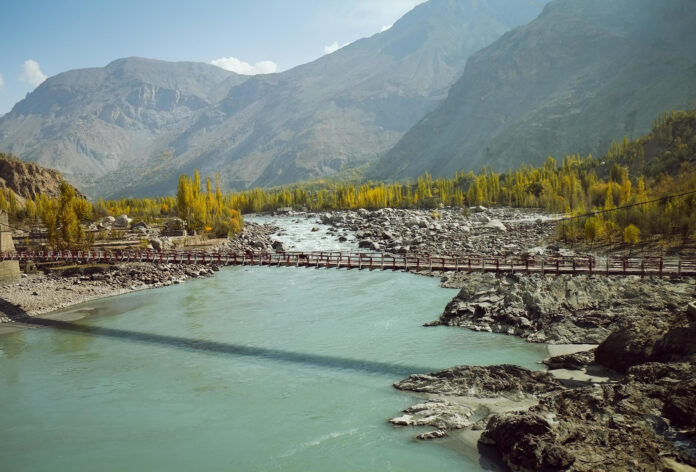
Pakistan’s federal government’s proposal to construct six new canals on the Indus River in Punjab has sparked strong opposition from Sindh, the downstream province heavily reliant on the river for irrigation. Sindh’s agricultural sector, which relies on the Indus for irrigating 77% of its cultivated land, is already under significant strain due to recurring water shortages of 40% to 45% annually. The proposed canals threaten to further deplete the province’s already scarce water resources, jeopardizing its agricultural output and the livelihoods of millions of people.
The Water Apportionment Accord of 1991, which governs the allocation of water among Pakistan’s provinces, ensures Sindh receives 42.64% of the total water resources. The accord also mandates a minimum annual flow of 10 million acre-feet (MAF) at the Kotri Barrage to curb seawater intrusion into the Indus Delta. However, the rights of the lower riparian are consistently overlooked during the dry season. Sindh has repeatedly raised concerns about the failure to implement these provisions, resulting in severe ecological damage and a decline in agricultural productivity within the province.
Sindh has consistently raised its concerns with federal institutions, including the Council of Common Interests (CCI), to protect its water rights. Recently, the formal protest led by Sindh’s Chief Minister in the CCI underscores the urgency of addressing these pressing issues. Political parties, human rights organizations, farmers’ associations, and nationalist groups have come together in opposition, organizing protests and demanding the full implementation of the 1991 Water Apportionment Accord.
Seawater intrusion into the Indus Delta poses significant threats to Sindh’s ecosystems and communities, particularly during dry periods when insufficient freshwater exacerbates salinity. This has jeopardized agriculture, fisheries, and natural habitats. The delta, covering 41,440 km² and housing the world’s seventh-largest mangrove forest, provides vital ecological services. However, reduced freshwater flows have led to rising salinity, waterlogging, and the loss of 0.5 million hectares of fertile land, causing the delta to shrink dramatically. As a Ramsar Wetland site, the delta is of international importance, but nearly half of Pakistan’s wetlands, including this one, are under threat, affecting around two million residents in Thatta, Sujawal, and Badin.
A recent study by PV Rajesh and BN Goswami, published in Earth’s Future[1], reveals a westward shift in the Indian monsoon, leading to reduced rainfall in northeastern regions and increased precipitation in western areas. This shift has heightened Sindh’s vulnerability to climate-induced disasters, with recurrent floods in 2010, 2011, 2020, and 2022 causing widespread devastation. The 2022 monsoon, in particular, saw rainfall anomalies exceeding 460% in Sindh, displacing thousands and destroying farmland. These catastrophic floods, exacerbated by excessive rainfall and inadequate drainage infrastructure, underscore the urgent need for proactive measures. Constructing smaller dams for flood and stormwater management, strengthening infrastructure in vulnerable areas, and implementing efficient early warning systems are essential steps.
The federal government’s Green Pakistan Initiative, which includes the Rs211.3 billion Cholistan Canal project, aims to boost agriculture in South Punjab. However, it has raised concerns in Sindh, where 18 million acres of farmland remain uncultivated due to water shortages. The project involves constructing a feeder channel to supply water to Bahawalnagar and Bahawalpur, but Sindh’s Chief Minister strongly opposed it, warning that it could worsen the province’s already critical water crisis and threaten the livelihoods of local farmers. Political parties, human rights organizations, farmers’ associations, and nationalist groups have united in their resistance, staging protests and demanding the full implementation of the 1991 Water Apportionment Accord. For many Sindhis, the canals evoke memories of the controversial Kalabagh Dam proposal, which was rejected due to concerns about water deprivation and ecological harm.
On the global stage, research by Feng and Gleason[2], analyzing streamflow data from 2.9 million rivers, highlights a rising trend in flow volumes in headwaters, but declining volumes at basin outlets. This trend exacerbates the frequency of upstream floods while leaving downstream areas like Sindh more vulnerable to water scarcity.
Given the challenges posed by climate change, changing monsoon patterns, and increasing water demands, it is crucial to promptly revise the 1991 Water Apportionment Accord to protect Sindh’s water rights. The revised accord should include contemporary strategies to address these evolving challenges.
To ensure fair water distribution and boost climate resilience, it is vital to develop small-scale, decentralized water storage systems and strengthen water management institutions. Implementing collaborative, forward-thinking policies is necessary to create an equitable framework that supports agricultural livelihoods and regional growth.
Additionally, improving Pakistan’s national water infrastructure is essential, including addressing drainage system issues, clearing blockages from canals, and investing in new drainage channels and lagoons to reduce reliance on diverting excess water into the sea. These combined efforts will help establish a sustainable water management system that meets current challenges and secures water resources for the future. Moreover, the revised 1991 Water Apportionment Accord should include a mutual agreement on federal government-funded irrigation and drainage projects to ensure that these initiatives benefit all provinces fairly.
In conclusion, addressing Sindh’s water rights and ensuring equitable resource distribution is not just a provincial concern but a national imperative. A revised 1991 Water Apportionment Accord, which integrates modern strategies for climate resilience, sustainable water storage, and improved infrastructure, is essential for safeguarding the livelihoods of millions. By fostering collaboration among provinces and investing in long-term, decentralized solutions, Pakistan can create a balanced and just water management framework. This approach will not only secure Sindh’s agricultural future but also promote the sustainable development of all provinces, ensuring a fair and prosperous future for the entire nation.
[1] Rajesh, P. V. and B. N. Goswami (2023). “Climate Change and Potential Demise of the Indian Deserts.” Earth’s Future 11(8): e2022EF003459.
[2] Feng, D. and C. J. Gleason (2024). “More flow upstream and less flow downstream: The changing form and function of global rivers.” Science 386(6727): 1305-1311.
